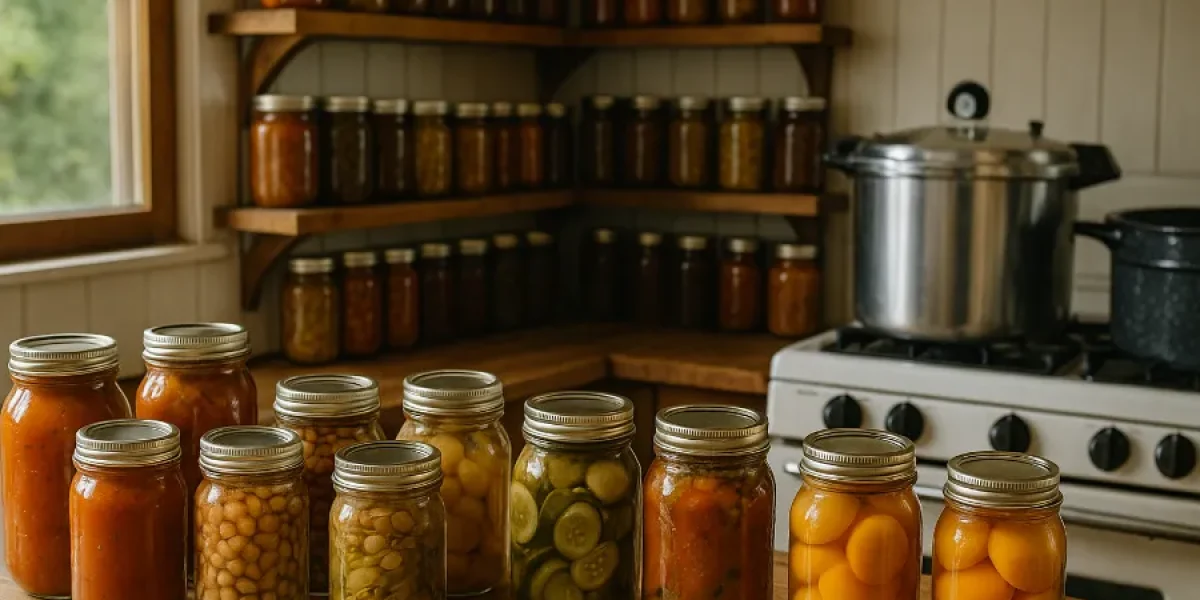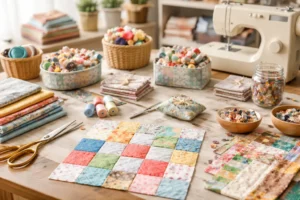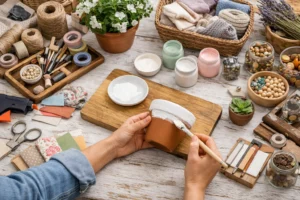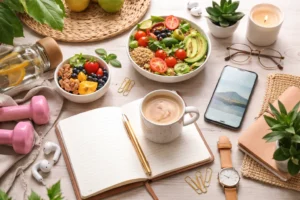Every homesteader knows the magic of a well-stocked pantry. Rows of gleaming jars, filled with the colors and flavors of every season that’s not just food storage; it’s self-sufficiency in glass form. And at the center of it all? Mason jars for canning the unsung heroes of the homestead kitchen.
Whether you’re putting up summer tomatoes, crafting cozy fall soups, or storing shelf-stable food for the long winter ahead, mastering your canning process is key to a thriving year-round pantry. Today, we’ll dive into homestead canning ideas that keep your pantry full, your food safe, and your lifestyle sustainable — with practical advice on tools, techniques, and organization.
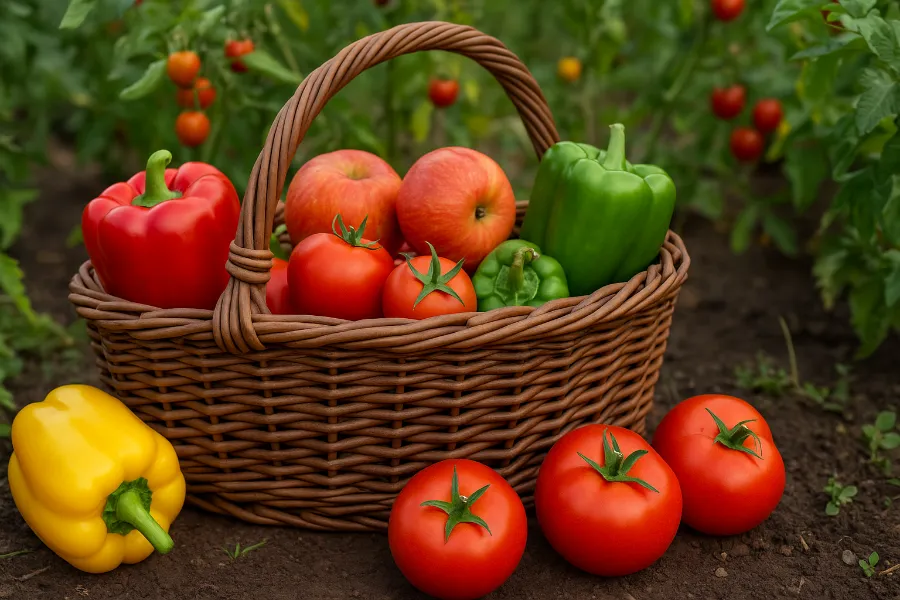
The Role of Mason Jars in Homestead Canning
There’s a reason mason jars for canning have been around since the 1800s — they work. Sturdy, reusable, and endlessly versatile, these jars preserve flavor, nutrition, and texture like nothing else.
When choosing mason jars for your homestead canning setup, think about these factors:
- Size: Half-pint jars are perfect for jams and jellies, pint jars for sauces or pickles, and quart jars for soups, fruits, or vegetables.
- Mouth Type: Regular-mouth jars are ideal for liquids or smaller produce, while wide-mouth jars make it easy to pack larger foods like peaches or meat.
- Quality Glass: Always use jars specifically made for canning. Recycled jars from store-bought foods aren’t designed to withstand the pressure or heat of processing.
- Reusable Lids & Bands: Use new lids each time for a perfect seal, but reuse metal bands and glass jars indefinitely with proper care.
Properly stored, a mason jar is more than just a container — it’s a sustainable investment that can last generations.
Water Bath Canning: A Homestead Staple
When it comes to preserving high-acid foods — like fruits, tomatoes, pickles, or jams — water bath canning is the simplest, most accessible method. It’s perfect for beginners and experts alike, using nothing more than boiling water and time to create a perfect vacuum seal.
Steps for Safe Water Bath Canning
- Prepare your jars: Wash in hot, soapy water and keep warm until ready to fill.
- Cook or pack your food: Hot-pack methods (like jams) work best for even sealing.
- Fill jars carefully: Leave ¼ to ½ inch of headspace to allow for expansion.
- Wipe rims and apply lids: A clean rim ensures no seal failures.
- Process in boiling water: Submerge jars at least one inch below water level and process according to your recipe and altitude.
- Cool and test seals: Once cooled, check that each lid is concave and doesn’t flex.
Water bath canning may seem old-fashioned, but it’s the backbone of any homestead canning plan. With the right timing and clean techniques, you’ll have jars that last for years.
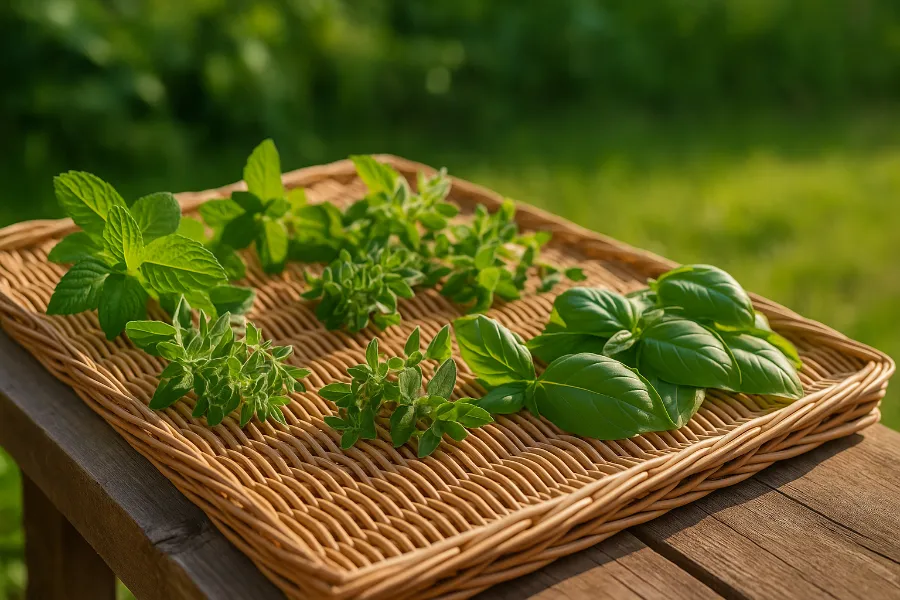
Food Preservation Techniques Every Homesteader Should Master
Food preservation is more than a skill it’s a way of life for anyone striving toward self-sufficient living. Beyond canning, there are multiple ways to extend your harvest’s shelf life.
1. Pressure Canning
For low-acid foods like vegetables, soups, or meats, pressure canning is non-negotiable. It heats food above boiling point (240°F or higher), killing bacteria that can survive in milder processes.
2. Dehydrating
Perfect for herbs, fruits, or jerky. Dehydration removes moisture and minimizes spoilage, taking up less space in your pantry.
3. Fermenting
Old-world and probiotic-rich think sauerkraut, kimchi, and kombucha. Fermentation adds depth of flavor and natural preservation through beneficial bacteria.
4. Freezing and Vacuum Sealing
Not traditional canning, but still a useful preservation backup. Frozen produce keeps color and nutrients well if sealed properly.
Each method supports your year-round pantry by diversifying your preserved foods — giving you choices from breakfast jams to hearty dinners.
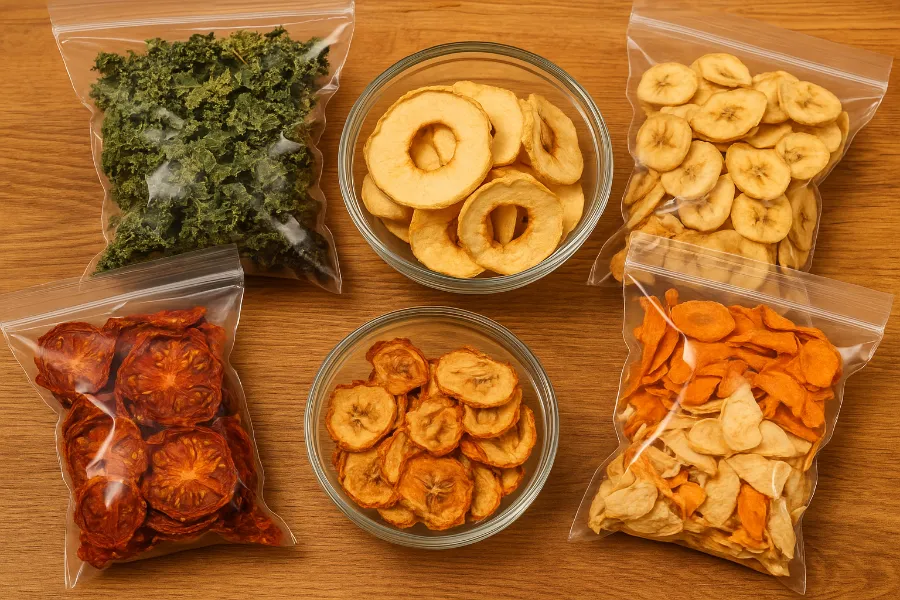
How to Can Soups Safely for Long-Term Storage
If there’s one comfort food every homesteader should have on the shelf, it’s homemade soup. From chicken noodle to vegetable beef, canned soups make quick meals without sacrificing nutrition or taste.
Here’s how to safely can soups using your pressure canner:
- Choose low-fat recipes. Too much fat can prevent proper sealing.
- Pre-cook ingredients. Cook meat and beans fully before canning.
- Avoid dairy or thickeners. Add cream or flour when serving, not before.
- Leave headspace. Usually about 1 inch for expansion.
- Process at correct pressure and time. Follow guidelines from the National Center for Home Food Preservation for your altitude.
Canned soups are ideal for busy weeks, emergency storage, or those nights when you want homemade comfort in minutes.
Shelf-Stable Food: The Heart of a Homestead Pantry
Shelf-stable food isn’t just about convenience — it’s about security. When power goes out or garden yields slow down, your preserved food is your safety net.
Mason jars make perfect vessels for a variety of shelf-stable items:
- Pickled vegetables: Cucumbers, carrots, okra, and beets.
- Fruits in syrup: Peaches, pears, cherries, and applesauce.
- Tomato-based products: Sauces, salsas, and purees.
- Broths and stocks: Vegetable, chicken, or beef for quick meal bases.
- Dried goods: Store flour, beans, rice, and herbs in airtight jars.
To ensure long shelf life, always store in a cool, dark, and dry place ideally between 50–70°F. Avoid direct sunlight and humidity to keep your jars safe and your food flavorful.
Pantry Organization Ideas for the Modern Homesteader
A pantry isn’t just storage it’s your home’s heart. Whether you have a full root cellar or a small kitchen shelf, smart pantry organization ideas make canning far more efficient.
Try These Proven Organization Systems:
- Categorize by type: Group fruits, vegetables, meats, and condiments.
- Label everything: Include the date and contents for easy rotation.
- First In, First Out (FIFO): Always use the oldest jars first.
- Use shelves with lips or guards: Prevents jars from shifting or falling.
- Track inventory: Keep a notebook or digital tracker to plan next season’s canning needs.
When your pantry is organized, you’ll instantly see what’s running low — and what needs replenishing when the next harvest comes.
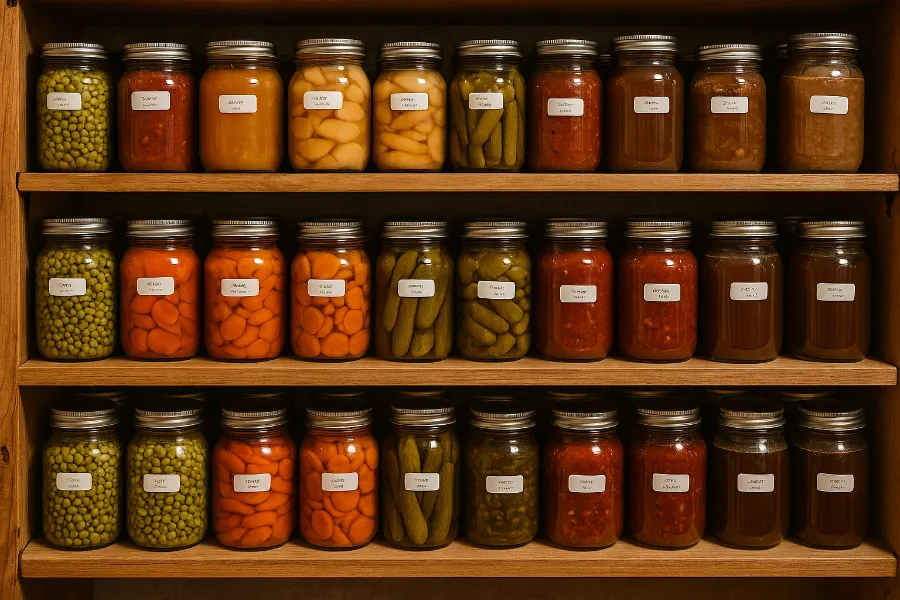
Sustainable Food Preservation for Self-Sufficient Living
At its core, homestead canning supports self-sufficient living a lifestyle rooted in independence, resourcefulness, and respect for nature’s cycles.
Canning teaches patience, precision, and creativity. It encourages you to use what you have, reduce waste, and store food without relying on modern refrigeration. Over time, you’ll discover which foods your family eats most and tailor your preservation plan accordingly.
Here’s how canning supports sustainability:
- Less food waste: Every extra tomato, apple, or pepper has purpose.
- Reusable materials: Mason jars and bands last for decades.
- Energy-efficient cooking: One canning session can produce dozens of meals.
- Local resilience: You’re less dependent on grocery stores or supply chains.
Each jar represents more than food — it’s a step toward freedom.
Practical Tips for Safe and Successful Home Canning
Even seasoned homesteaders double-check the basics. A few simple habits can mean the difference between success and spoilage.
- Always use new lids. Old lids can’t guarantee airtight seals.
- Inspect jars for cracks. Weak glass can break during processing.
- Follow tested recipes. The National Center for Home Food Preservation and Ball’s Blue Book are trusted sources.
- Mind your headspace. Too full or too empty can affect sealing.
- Cool jars naturally. Never force-cool by setting in cold water.
- Label everything. Include date and type for easy rotation.
These habits become second nature — and they keep your pantry safe, efficient, and trustworthy.
Combining Canning and Pantry Planning for Year-Round Food Security
Canning isn’t just a task; it’s a rhythm that connects you to the seasons. Plan your pantry by aligning your canning projects with nature’s harvests:
| Season | Canning Focus | Examples |
|---|---|---|
| Spring | Jams, jellies, and pickled greens | Strawberry jam, pickled asparagus |
| Summer | Tomatoes, peaches, cucumbers | Tomato sauce, salsa, dill pickles |
| Fall | Apples, pumpkin, hearty stews | Applesauce, pumpkin butter, soup base |
| Winter | Meats, beans, and broths | Pressure-canned venison, chili, stock |
By staggering your projects, you maintain variety and balance — keeping every season alive in your pantry.
Food Preservation Techniques for Flavor and Safety
Not all canning is about shelf life — it’s about maintaining taste, texture, and nutrition. These food preservation techniques help your food stay as fresh as the day you picked it.
- Hot Packing: Preheat food before sealing to remove air bubbles.
- Add Acid When Needed: Tomatoes and salsas need lemon juice or citric acid for safety.
- Monitor Headspace: Prevents spoilage and ensures strong seals.
- Avoid Overprocessing: Too much heat can dull color and texture.
- Store Smart: Keep jars upright, away from direct light and moisture.
Small adjustments like these add up to big improvements in quality and safety.
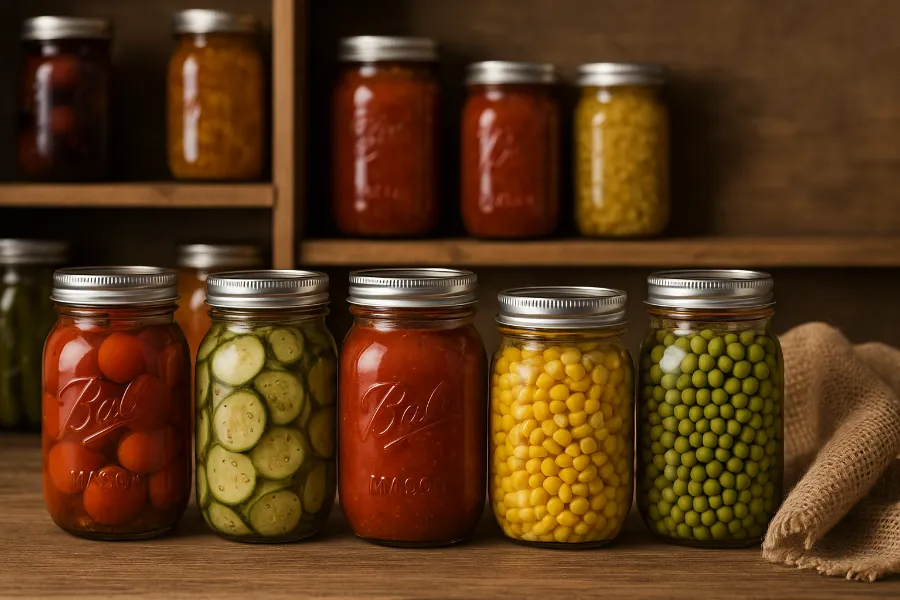
Food Preservation Beyond the Pantry
While canning is the star of the show, food preservation extends beyond jars.
Try blending these methods for complete homestead resilience:
- Root Cellaring: Store potatoes, carrots, beets, and apples naturally underground.
- Dry Storage: Grains, beans, and seeds keep well in sealed mason jars.
- Fermented Condiments: Homemade ketchup, mustard, and pickles last months.
- Sun-Drying Herbs: Dry mint, basil, or oregano for year-round seasoning.
Together, these systems build a pantry that’s practical, diverse, and entirely your own.
The Joy of a Well-Stocked Homestead Pantry
There’s something deeply satisfying about standing in front of shelves filled with your own handiwork — each jar a story of seasons past. It’s not just about food; it’s about self-sufficiency, tradition, and pride.
From water bath canning to pressure canning soups, from pantry organization ideas to mastering food preservation techniques, every part of the process brings you closer to a life of abundance and independence.
So gather your mason jars, roll up your sleeves, and start filling your shelves.
Your homestead canning pantry isn’t just a storage space — it’s a living symbol of your hard work, resilience, and love for good food.
FAQs
Mason jars are heat-treated and designed to handle the high temperatures of water bath or pressure canning. Regular jars may crack, leak, or fail to seal properly.
No, lids should only be used once because the sealing compound weakens after each use. However, the glass jars and metal bands can be reused indefinitely if undamaged.
High-acid foods like fruits, jams, jellies, pickles, and salsas are ideal for water bath canning. Low-acid foods require pressure canning for safety.
Properly sealed and stored jars can last 12 to 18 months while maintaining flavor and nutrition. Keep them in a cool, dark, and dry location for best results.
Yes, but soups must be pressure canned to reach safe temperatures. Always avoid adding dairy or thickeners before canning—add those when serving.
Group jars by type and date, label everything clearly, and follow the “first in, first out” rule. Shelving with guard rails prevents accidental breakage.
Canning reduces waste, saves money, and provides food security through every season. It’s a practical way to live sustainably and rely less on grocery stores.

